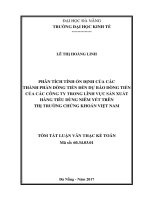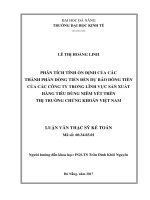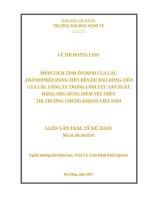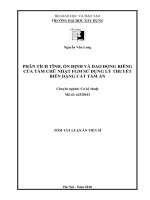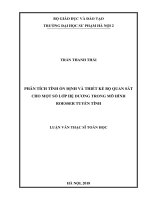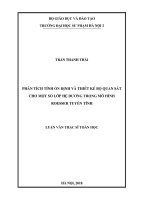Phân tích tính ổn định kết cấu dầm bơm hơi vật liệu composite
Bạn đang xem bản rút gọn của tài liệu. Xem và tải ngay bản đầy đủ của tài liệu tại đây (5.51 MB, 254 trang )
MINISTRY OF EDUCATION AND TRAINING
HCM CITY UNIVERSITY OF TECHNOLOGY AND EDUCATION
---oo0oo---
PHAN THI DANG THU
BUCKLING ANALYSIS OF INFLATABLE
COMPOSITE BEAMS
PHD THESIS
MAJOR: MECHANICAL ENGINEERING
CODE: 9520103
HCM City, August 2021
MINISTRY OF EDUCATION AND TRAINING HCM CITY
UNIVERSITY OF TECHNOLOGY AND EDUCATION --- oOo ---
PHAN THI DANG THU
BUCKLING ANALYSIS OF INFLATABLE
COMPOSITE BEAMS MAJOR: MECHANICAL
ENGINEERING CODE: 9520103
Supervisor one : Assoc. Prof. Dr. Phan Dinh Huan
Supervisor two : Assoc. Prof. Dr. Le Hieu Giang
Reviewer 1:
Reviewer 2:
Reviewer 3:
HCM City, August 2021
LÝ LỊCH CÁ NHÂN
I. LÝ LỊCH SƠ LƯỢC
Họ và tên:
Ngày, tháng, năm sinh:
Quên quán:
Học vị cao nhất: Thạc Sỹ Kỹ thuật
Đơn vị công tác: Trường Cao Đẳng Công Nghệ Thủ Đức
Chỗ ở riêng hoặc địa chỉ liên lạc: B2-14/09 c/c Lê Thành, Phường An Lạc, Quận Bình
Tân, TP.HCM
Điện thoại liên hệ: 0903373645
Email:
II. QUÁ TRÌNH ĐÀO TẠO
1. Đại học:
- Hệ đào tạo: Chính qui
- Nơi đào tạo: Trường Đại học Sư phạm Kỹ thuật TP. HCM
- Ngành học: Kỹ thuật công nghiệp
- Năm tốt nghiệp: 2000
2. Sau đại học
- Hệ đào tạo: Chính qui
- Nơi đào tạo: trường Đại học Sư phạm Kỹ thuật Tp. HCM - Việt Nam
- Thạc sĩ chuyên ngành: Kỹ thuật cơ khí
- Năm tốt nghiệp: 2004
III. Q TRÌNH CƠNG TÁC
- 2000-2005: Giảng viên - Trường Cao đẳng Bán công Công nghệ và quản trị doanh
nghiệp.
- 2005-2019: Giảng viên, Trưởng khoa Cơ khí - Trường Cao đẳng nghề TPHCM
- 2019-2020: Giảng viên, Giám đốc trung tâm - Viện khoa học An toàn vệ sinh lao
động TPHCM
i
- 2020 đến nay: Giảng viên - Trường Cao đẳng Cơng nghệ Thủ Đức TPHCM
IV. LĨNH VỰC CHUN MƠN
- CAD/CAM/CNC
- Gia cơng CNC
- Thiết kế kỹ thuật cơ khí
V. CÁC CƠNG TRÌNH ĐÃ CƠNG BỐ
Số
NỘI DUNG
TT
1
T. Le-Manh, Q. Huynh-Van, Thu D. Phan, Huan D. Phan, H. Nguyen-Xuan
“Isogeometric nonlinear bending and buckling analysis of variablethickness
composite plate structures”; Composite Structures 1 January 2017, Pages
818-826.
2
Phan Thi Dang Thu, Phan Dinh Huan and Nguyen Thanh Truong “Effect
parametric to properties of a 2D orthogonal plain classical woven fabric
composite”; ISBN: 978-604-913-367-1, pages 509-517.
3
Phan Thi Dang Thu, Phan Dinh Huan and Nguyen Thanh Truong “Biaxial
beam inflation test on orthotropic fabric beam”; ISBN: 978-604-913-213-1,
pages 1169-1176.
4
Nguyen Thanh Truong, Phan Dinh Huan, Phan Thi Dang Thu “Discretizing
an analytical inflating beam model by the shellmembrane finite elelment”;
ISBN: 978-604-913-213-1, pages 1221-1228.
5
Phan Thi Dang Thu, Le Manh Tuan, Nguyen Xuan Hung, Nguyen Thanh
Truong “Geometrically nonlinear behaviour of composite beams of variable
fiber volume fraction in isogeometric analysis”; ISBN: 978-604-82-2028-0,
Pages: 1404-1409.
6
Thu Phan-Thi-Dang, Tuan Le-Manh, Giang Le-Hieu, Truong NguyenThanh “Buckling of cylindrical inflating composite beams using
isogeometric analysis”; ISBN: 978-604-73-3691-3, Pages 821-826.
Số
NỘI DUNG
TT
7
Phan Thi Dang Thu, Nguyen Thanh Truong, Phan Dinh Huan “Mơ hình
dầm hơi composite phi tuyến chịu uốn”; ISBN: 976-604-82-2026-6, Page
697-704.
8
Phan Thi Dang Thu, Nguyen Thanh Truong, Phan Dinh Huan, Le Dinh
Tuan “Biaxial experiments for determining material properties and joint
strength of textile plain woven fabric composites”; ISBN: 978-604-913722-8, Page 1174-1181.
TP. HCM, ngày 12 tháng 8 năm 2021
Nghiên cứu sinh
Phan Thị Đăng Thư
iii
ORIGINALITY STATEMENT
I, Phan Thị Đăng Thư, hereby assure that this dissertation is my own work,
done under the guidance of Assoc. Prof. Dr. Phan Dinh Huan and Assoc. Prof. Dr.
Le Hieu Giang with the best of my knowledge.
All results and data that are stated and presented in this dissertation are
honest. And they have not been published by any previous works.
Ho Chi Minh City, August 2021
Phan Thi Dang Thu
ACKNOWLEDGEMENTS
The dissertation is implemeted at the Faculty of Mechanical Engineering, Ho
Chi Minh City University of Technology and Education, Viet Nam. The conducting
process of this thesis not only brings motivation, but it also takes several challenges
and difficulties. Without any support and coopperating by my professors, colleagues as
well as my students, this thesis would not be achieved completely and fluently.
That is why, first of all, I would like to express my appreciation to Assoc.
Prof. Phan Dinh Huan and Assoc. Prof. Le Hieu Giang, for accepting me as a PhD
student and for their enthusiastic guidance during my research. Moreover, I would
like to kindly thank Dr. Nguyen Thanh Truong, Dr. Le Manh Tuan, Mr. Duong Chi
Hung (a young brothers), for their helpful supporting in every first steps of doing
research. They conscientiously helped me to overcome during my hardest time.
Secondly, I would like to acknowledge Assoc. Prof. Le Dinh Tuan, Faculty of
Transportation Engineering, Ho Chi Minh City University of Technology, Vietnam,
who troubleshooted my troubles and helped to solve problems incidentally
occurring in my study.
Thirdly, I also take this chance to thank all my talent colleagues for their
professional instruction and advice, as well as to my lovely students for their nicely
support.
Last but not least, the family’s love and encouragement are definitely my
biggest motivation. They gave me plenty of valuable assistance with their love and
affection.
Phan Thi Dang Thu
v
ABSTRACT
This thesis presents a numerical modeling and an experimental program
approach to investigate the buckling behavior of inflatable beams made from woven
fabric composite materials.
In the numerical study, the Isogeometric Analysis (IGA) is utilized to analyze
the bucking response of inflatable beams subject to axial compressive load and
predict the critical load at which the first wrinkle occurs. In the numerical model,
the Timoshenko’s kinematics principle is used to build a 3D model of inflating
orthotropic beams. In this modeling process, geometrical non-linearity is
considerated by using the energy concept that accounts for the change in membrane
and strain energies when the beams are bent. By using Lagrangian and virtual work
principles, nonlinear equilibrium equations were derived. These equations are then
discretized by using NURBS basis functions inherited from IGA approach to derive
the global nonlinear equation. The well-known Newton-Raphson algorithm is then
used to solve the nonlinear equation. The numerical results are then calibrated with
the experimental one. It was found that a good agreement between IGA predictions
and test results is achieved. The numerical model could be used for other parametric
studies to investigate the influences of material and geometrial parameters on the
buckling behaviour of inflatable beams.
In the experiment study, the mechanical properties of the woven fabric
composite material used in frabrication of inflatable beams are determined and the
biaxial buckling test is carried out. The experimental studies are performed under
various inflation pressures to characterize the orthotropic mechanical properties and the
nonlinear buckling behaviors. Load versus deflection curve of inflating beams beam
with different air pressures obtained from the experimentsare are illustrated., and the
first wrinkles of the beams when buckling happens is also monitored. Therefore, the
maximum load carrying capacity of the inflating beam with respect to the appearance
of the first wrinkle is totally found. In addition, the critical buckling
load is determined through distinct load cases. Then, the discrepancy is evaluated
among the proposed orthotropic and isotropic models in literature.
vii
Contents
BIOGRAPHY ............................................................................................................
ORIGINALITY STATEMENT ............................................................................
ACKNOWLEDGEMENTS .....................................................................................
ABSTRACT ............................................................................................................
CONTENTS .........................................................................................................
NOTATIONS AND CONVENTIONS ................................................................
LIST OF FIGURE ............................................................................................
LIST OF TABLE ..............................................................................................
CHAPTER 1: INTRODUCTION ............................................................................
1.1
Background information ................................................................................
1.2
Motivation of the thesis ...................................................................................
1.3
The objectives and scope of the study ............................................................
1.4
Methodology ..................................................................................................
1.5
Outline of the thesis ........................................................................................
1.6
Original contributions of the thesis .................................................................
1.7
Significances of the thesis ...............................................................................
CHAPTER 2: LITERATURE REVIEW ................................................................
2.1
An overview of fibous composite materials ...................................................
2.1.1
Fiber types ...........................................
2.1.2
Matrix Materials .................................
2.1.3
Composite Properties ..........................
2.1.4
Advantages of composite ....................
2.2
Practical applications of inflating composite structures ...............................
2.2.1
Aerospace ............................................
2.2.2
Civil engineering and architecture ......
2.2.3
Other fields of application ..................
2.3 Analyses of inflating structures......................................................................... 22
2.3.1 Analytical approach.................................................................................... 22
2.3.2 Numerical approach................................................................................... 24
2.4 Conclusions....................................................................................................... 27
CHAPTER 3: THEORETICAL FORMULATIONS......................................... 29
3.1 Overview and basics of Isogeometric Analysis................................................. 29
3.1.1 Advantages of IGA in comparison with FEM............................................ 30
3.1.2 Disadvantages of IGA................................................................................ 31
3.1.3 Bézier Curves............................................................................................. 32
3.1.4 B-Spline..................................................................................................... 33
3.1.4.1 Knot Vector......................................................................................... 33
3.1.4.2 B-Spline Basis Functions.................................................................... 34
3.1.4.3 B-Spline Curves.................................................................................. 35
3.1.5 NURBS Curves.......................................................................................... 36
3.1.6 NURBS Refinement................................................................................... 38
3.1.7 Continuity.................................................................................................. 40
3.1.8 Isogeometric Analysis................................................................................ 43
3.1.9 NURBS-based elements for IGA............................................................... 45
3.1.10 Isogeometric Analysis versus Classical Finite elementingAnalysis.........48
3.2 Cotinnum-based governign equations of stability problems of inlfating beams 49
3.2.1 Mathematical description of inflating beams............................................. 50
3.2.2 Theoretical formulation.............................................................................. 52
3.2.2.1 Kinematic relations............................................................................. 52
3.2.2.2 Constitutive equations........................................................................ 54
3.2.3 Virtual work principle................................................................................ 56
3.3 Conclusion........................................................................................................ 65
CHAPTER 4: IGA-BASED BUCKLING ANALYSIS OF INFLATING
COMPOSITE BEAMS......................................................................................... 67
4.1 Introduction....................................................................................................... 67
ix
4.2 IGA-based formulations for the buckling problems of inflating composite beams
...................................................................................................................................
4.2.1Linear eigen buckling ......................
4.2.2Nonlinear buckling ..........................
4.2.3Implementation of an iterative algori
4.3
Numerical examples .............................................................................
4.3.1Linear buckling analysis ..................
4.3.1.1 Simply-supported beam .........................................................
4.3.1.2 Fixed – Free beam ..................................................................
4.3.2Nonlinear analysis.............................
4.3.2.1 Simply-supported beam .........................................................
4.3.2.2 Fixed-free beam .....................................................................
4.4
Conclusions ..........................................................................................
CHAPTER 5: BUCKLING EXPERIMENTS OF INFLATING BEAMS ........
5.1
Introduction ..........................................................................................
5.2
Material properties and selection of fabrics .........................................
5.2.1The woven fabric materials .............
5.2.2Testing equipments ...........................
5.2.3Mechanical properties of woven fabr
5.3
Test of joint’s durable strength ...........................................................
5.3.1Glued joint PVC 1cm ......................
5.3.2Glued joint PVC 1cm thermal .........
5.3.3Glued joint PVC 2cm thermal .........
5.3.4Glued joint PVC 2.5 cm with therm
5.4
Inflatable beam specimens .................................................................
5.5
Buckling test set-up .............................................................................
5.6
Experimental results and discussion ..................................................
5.6.1Load vs displacement u relation of b
5.6.1.1 Beams inflated with different air pressures ..........................
5.6.1.2 Comparison of 3 beams at pressure p = 80 kPa ....................
5.6.2 Load vs displacement v relation of beam at pressure...............................133
5.6.2.1 Beams inflated with different air pressures....................................... 142
5.6.2.2 Comparison of 3 beams at pressure p = 80 kPa................................145
5.7 Comparison between experimental and IGA numerical methods....................146
5.8 Conclusion....................................................................................................... 148
CHAPTER 6: CONCLUSIONS AND FURTHER STUDIES..........................150
6.1 Conclusions..................................................................................................... 150
6.2 Further studies................................................................................................. 151
REFERENCES.................................................................................................... 152
LIST OF PUBLICATIONS................................................................................. 164
xi
Notations and conventions
Abbreviations
CAD
Computer Aided Design
FEA
Finite Element Analysis
IGA
Isogeometric Analysis
FGM
Functionally graded material
3D
Three dimensional
NURBS
Non-Uniform Rational B-splines
DOF
Degree of Freedom
OPCWFC
Orthogonal plain classical woven fabric composite
FE
Finite element
FEM
Finite elementingmethod
HOWF
Homogeneous orthotropic woven fabric
LFEIB
Linear finite elementinginflating beam
NLIBFE
Nonlinear inflating beam finite element
Plain weave fabric testing
(x, y)
Axes of symmetry of plain weave fabric specimen
(L, T)
Axes of symmetry of textile fabric, which are assumed
to represent the axes of material symmetry (L: warp
direction; T: weft direction)
Textile composite parameters and mechanical properties
t
Fabric thickness
El
Warp effective Young’s modulus
Et
Weft effective Young’s modulus
G
In-plane effective shear modulus
lt
lt
Poisson ratio due to the loading in the warp
and contraction in the weft
tl
Poisson ratio due to the loading in the weft
and contraction in the warp
Constants
c
cos
s
sin
Structural mechanics of inflating beams
Coordinates systems
l,t,n
(X, Y, Z)
(e
Warp, weft, normal
directions of the
fabric Cartesian
coordinates
=
(e
n)
Z
Unit vectors of the
,
cartesian
coordinates Angle
Mechanical properties
E
G
E
G * = Gt'
El
Et
G
l
t
lt
tl
Yo
un
g
mo
dul
us
of
the
iso
tro
pic
fab
ric
ear modulus
of the
isotropic
fabric
Sh
ear
mo
dul
us
of
the
iso
tro
pic
fab
ric
direction of
M
em
bra
ne
ela
sti
c
mo
dul
us
of
the
iso
tro
pic
fab
ric
fabric
M
em
bra
ne
sh
traction
Poisson
ratio of the
isotropic
fabric
Modulus of
elasticity in
warp
the
orthotropic
fabric
Modulus of
elasticity in
weft
direction of
the
orthotropic
In-plane
shear
modulus of
the
orthotropic
fabric
Poisson
ratio
relative to
the
contraction
of the warp
under weft
Poisson
ratio
relative to
contraction of the weft under warp
the
traction
xiii
fx ,
G
Internal forces
N
T
Beam geometry
l
R
t
l
l
o
R
t
A
Io
Loads
F
FX,FY,FZ
M
Equivalent Young’s
modulus of the
orthotropic fabric
Equivalent shear
modulus of the
orthotropic fabric
Equivalent Poisson
ratio of the
orthotropic fabric
Level of orthotropy
Parameter to measure
the difference
between Glt and Geq
Elasticity tensors
Axial force
Shear force along y
and z axes
Moments around y
and z axes
Natural length of the
inflating beam
Natural radius of the
inflating beam
Natural thickness of
the inflating beam
Natural length of the
inflating beam
Reference length of
the inflating beam
Reference radius of the inflating beam
Reference thickness of the inflating beam
Reference cross-section area of the inflating beam
Reference moment of inertia of the inflating beam
Compressive concentrated load
Components of concentrated loads
Components of the distributed load
Components of bending moments
Fw
Wrinkling load
Fcrushing
Crushing load
Pressure, pressure forces
p
p
n
F
p
N
Coeffici
ents
Inf
lati
on
pre
ssu
re
No
rm
ali
ze
d
inf
lati
on
pre
ssu
re
Pressure
force
Axial force
due to the
inflation
pressure
Kinematics
u
u
v, w
Tensors
E , E
YZ
ZZ
E
EXX , EXY EXZ , EYY
EYZ , EZZ
S
S
, S
XX
XY
Shear correction
coefficients
Displacements field
Axial displacement
Deflections along Y
and Z axes
Rotations around Y
and Z axes
Green-Lagrange
tensor
Components of E
Virtual GreenLagrange tensor
Components of E
Second PiolaKirchhoff tensor
xv
S
Components of
S
YZ
S
Inflation pressure prestressing tensor
Functions and constants
E
Strain energy function
W
Internal virtual work
int
W
ex
t
External virtual work
External virtual
Wd
work of the
ext
W
service load
p
ext
External virtual
work of the
pressure load
Quantities depending on the initial
geometry of the cross-section
Matrix and tensors for finite
elementingformulations
D
d
D
R
D
Fint
k
Fext
K
K
K
KT
Di
No
dal
d.o
.f
Be
am
d.o
.f
Bu
ckl
ing
dis
pla
ce
me
nts
El
em
ent
co
nv
ent
ion
al
ela
sti
c
stif
fne
ss
ma
tri
x
El
em
ent
ini
tial stress
stiffness
matrix
Beam
conventiona
l elastic
stiffness
matrix
Beam initial
stress
stiffness
matrix
Beam
tangent
stiffness
matrix
Beam
displaceme
nt vector at
increment
step i
Nodal
unknown
displaceme
nt
increment
Beam
residual
load
Internal
load vector
of the beam
External
load vector
of the beam
N
Shape function matrix
B
Strain-displacement matrix
Aspect ratios
Linear eigen buckling
Kcl
Normalized linear buckling load coefficient
s
Slenderness ratio of the beam
Rrt
Radius-to-thickness ratio
R
Bending radius ratio
br
Nonlinear buckling
K
Normalized nonlinear load parameter
Incremental load ratio
K
R
Length-to-radius ratio
Flexion-to-radius ratio
R
xvii



